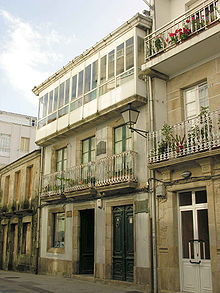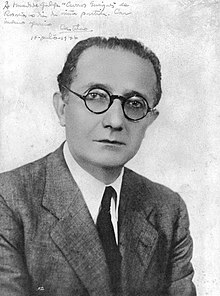Alfonso Daniel Rodríguez Castelao
Alfonso Daniel Rodríguez Castelao (born January 30, 1886 in Rianxo , Galicia , Spain ; † January 7, 1950 in Buenos Aires , Argentina; pseudonym: Castelao ) was a Galician writer , caricaturist , illustrator , doctor and politician as well as one of the founders of Galician Nationalism.
Life
Alfonso Daniel Rodríguez Castelao was the son of the fisherman Manuel Rodríguez Dios and Joaquina Castelao Genme. When he was three months old, his father emigrated to Argentina . At the end of 1885, Alfonso Daniel and his mother followed him to live together in Bernasconi , in the province of La Pampa. Castelao stayed there until 1900 and, according to his own statements, discovered his fondness for caricatures while reading the weekly newspaper Caras y caretas .

In 1900 he returned to his hometown Rianxo and studied medicine at the University of Santiago de Compostela from 1903 to 1908 . During his student years his interest in painting and drawing, especially caricatures, increased. In 1908 he exhibited his drawings in Madrid and began working with the magazine Vida Gallega . From 1909 to 1910 he did his doctorate in Madrid, took part in the 3rd national humorist exhibition and worked as an illustrator for El Cuento Semanal . In 1910 he specialized in obstetrics and then returned to his hometown. In this episode of his life he founded the weekly newspaper El Barbero Municipal (1910-1914) with, in which he criticized the Galician cacique rule .
In 1911 he gave his first conference on caricatures in Vigo , in 1912 he joined the Acción Gallega (Galician Action) movement and married Virxinia Pereira in October of the same year. During those years he published his cartoons in various newspapers and gained popularity.
In 1916 he got a job at the geographic statistical institute in Pontevedra and in those years he participated in the founding of the local department of the Galician nationalist movement Irmandades da Fala (brotherhoods of language).
Together with Vincente Risco, Otero Pedrayo and others, he founded the magazine Nós (We), in whose environment Galicia flourished between 1920 and 1936.
In January 1921 he traveled through France , Belgium and Germany to get to know the art of these countries better. He published part of the diary of this trip in the magazine Nós . It was published posthumously in book form in 1977 with the name Diario 1921 ( Diario 1921). In 1926 he was appointed a member of the Royal Galician Academy.
His son Alfonso died in January 1928 at the age of eleven. In the same year he went on a study trip to Brittany with his wife to research the Breton stone crosses. He published the result of this trip in May 1930 in the book As Cruces de Pedra na Bretaña (The Stone Crosses in Brittany). In 1931 he was elected as an independent Galician to the parliament of the Second Spanish Republic and co-founded the Galician party Partido Galeguista .
Because of his membership in the Galician Academy, he was exiled to Badajoz in November 1934 . During his stay there he wrote a series of articles for A Nosa Terra (Our Land), the mouthpiece of the Galician party, which he later incorporated into his work Semper en Galiza (Always in Galicia). His expulsion was overturned in September 1935, and in 1936 he was re-elected to parliament as a candidate for the Frente Popular ('Popular Front'). In the advertising campaign for the Galician Statute of Autonomy of 1936 he took a prominent position.
The military coup of 1936, which culminated in the Spanish Civil War , surprised him in Madrid, whereupon he moved to Valencia in late 1936 and later to Barcelona . In 1938 he emigrated first to New York and finally to Buenos Aires in 1940 . As a result, he participated, among other things, in the Galician government in exile in Paris.
He died on January 7, 1950 in Buenos Aires. His remains were transferred to Galicia in 1984.
Artistic and literary work

In addition to his political career, Castelao was versatile, active as a novelist, draftsman, caricaturist, painter and art theorist. His worldview and his commitment to the Galician movement were always reflected in his work. In exile during Franquism , he wrote the political essay Semper en Galiza , which became the central text of Galician nationalism.
His drawings, accompanied by brief texts, describe the rural Galicia, the Kazikentum, the suffering Galician people, the poor, the blind and the homeless from a realistic and critical but at the same time humorous point of view. In the album Nós he collected drawings from the period from 1916 to 1918, the later albums deal with the horrors of the civil war.
His first narrative work was the short narrative sequences from another perspective under the title Un ollo de vidro. Memorias dun esquelete (a glass eye. Memories of a skeleton) from 1922, with cover picture and 6 lithographs by the author. The writing fiction - the skeleton puts on paper what the glass eye could see during his lifetime - creatively implements the concept of humorism, which Castelao in his lecture Humorismo. Dibuxo humorístico. Caricatura in March 1920. With Cousas (things), Retrincos (shards) and Os dous de semper (the same two forever) and as a highlight Semper en Galiza , he created a total work of art that is unique for Galician literature, in which he explores literature, politics and the theoretical basis of the Galician movement Association. In his literary view of things, he used to reveal the stereotypes of costumbrismo with sarcastic, sometimes grotesque humor .
Political opinions
Castelao was a Galician nationalist, federalist , pacifist , progressivist and internationalist . He saw the autonomy granted to Galicia by the second Spanish republic as a means of establishing a Galician state in association with other Iberian nations. He was also a staunch supporter of a united Europe.
Concept of Spain
Castelao always used the name Hespaña , derived from Hispania , the Latin name for the Iberian Peninsula, instead of España ( Spain ), which, however, referred not only to the country but to the entire Iberian Peninsula . His idea of Hespaña was that of a federation of Iberian nations, namely Castile , Catalonia , the Basque Country , Portugal and Galicia. He demanded this from both a political and a cultural side.
He rejected the classic model of Iberian federalism, as this included the unification of the two Iberian states Spain and Portugal as such, and not his concept of the five Iberian nations. He pointed out that it was necessary for the Spanish state to break up so that the individual nations could come together in the form of free states . According to him, Spain was under a disproportionately high influence from Castile, which was about to take over the other nations and regions.
In the last years of his life, however, Castelao advocated the idea of complete Galician independence, as Semper en Galiza and other writings show.
Views on the Galician language
Although Castelao was bilingual ( Spanish and Galician ), he wrote and published almost exclusively in Galician language. As an advocate of the Galician language and culture, he viewed the language as a link between the Galician people. He criticized the imposition of the Spanish language in Galicia and demanded that Galician should become the official language and thus the preferred language in administration and education.
Castelao stressed that the Galician and Portuguese languages not only have a common origin , but also have a common future. Thus he represented a perspective similar to that of the later reintegrationists. In his travels through Portugal and Brazil he was amazed at how easily he could communicate with speakers of Portuguese using his Galician mother tongue. Even so, he never used Portuguese orthography .
Works
- Cego da romería (1913)
- Diario (1921)
- Un ollo de vidro (1922)
- Memorias dun esquelete (1922)
- Cousas (1926, 1929)
- Cincoenta homes por dez reás (1930)
- As cruces de pedra na Bretaña (1930)
- Nós (1931)
- Os dous de semper (1934)
- Retrincos (1934)
- Galicia Mártir (1937)
- Atila en Galicia (1937)
- Milicianos (1938)
- Semper en Galiza (1944)
- Os vellos non deben de namorarse (piece performed in 1941, published posthumously in 1953)
- As cruces de pedra na Galiza (published posthumously in 1950)
Web links
- Museo Castelao.org ( Memento of August 13, 2007 in the Internet Archive ) - biography, bibliography, information about the museum (in Galicich)
- Biography of Castelaus (in English)
- Selected quotes from Castelao on language and politics (in Galician)
- "Castelao y Casares Quiroga" - Article about Castelao and Santiago Casares Quiroga (in Spanish)
- "Theoretical Conceptualization of Emigration and Exile in Alfonso Rodriguez Castelao's Semper en Galiza " , by Mel Bohn (in English; PDF file; 77 kB)
| personal data | |
|---|---|
| SURNAME | Rodríguez Castelao, Alfonso Daniel |
| ALTERNATIVE NAMES | Castelao (stage name) |
| BRIEF DESCRIPTION | Galician writer, draftsman and politician |
| DATE OF BIRTH | January 30, 1886 |
| PLACE OF BIRTH | Rianxo , Spain |
| DATE OF DEATH | January 7, 1950 |
| Place of death | Buenos Aires , Argentina |
